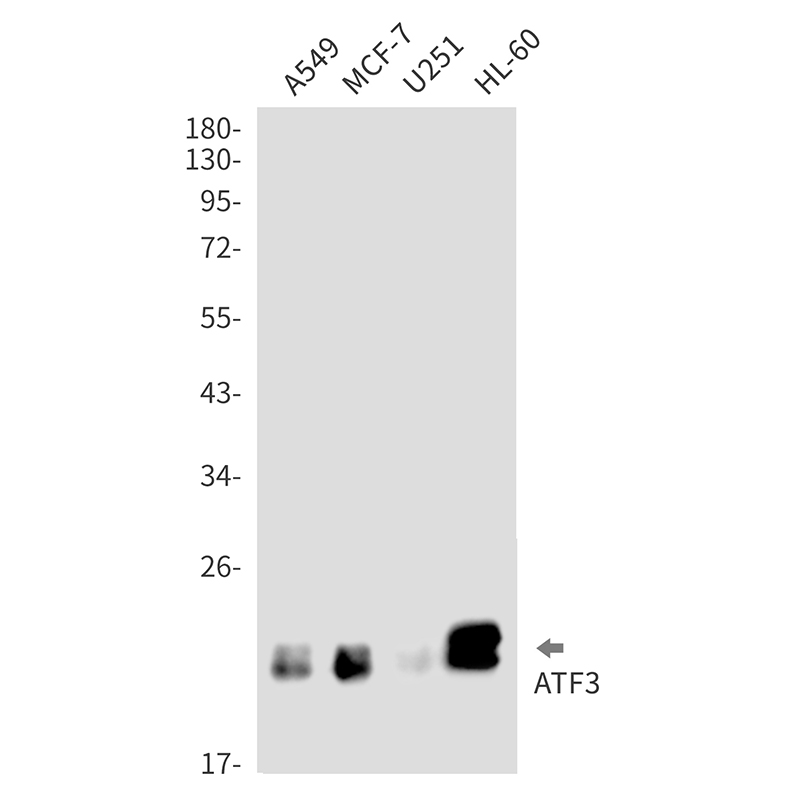
| WB | 1/500-1/1000 | Human,Mouse,Rat |
| IF | 咨询技术 | Human,Mouse,Rat |
| IHC | 咨询技术 | Human,Mouse,Rat |
| ICC | 技术咨询 | Human,Mouse,Rat |
| FCM | 咨询技术 | Human,Mouse,Rat |
| Elisa | 咨询技术 | Human,Mouse,Rat |
| Aliases | activating transcription factor 3 |
| Entrez GeneID | 467 |
| WB Predicted band size | Calculated MW: 21 kDa; Observed MW: 21 kDa |
| Host/Isotype | Rabbit IgG |
| Antibody Type | Primary antibody |
| Storage | Store at 4°C short term. Aliquot and store at -20°C long term. Avoid freeze/thaw cycles. |
| Species Reactivity | Human |
| Immunogen | Recombinant protein of human ATF3 |
| Formulation | Purified antibody in TBS with 0.05% sodium azide,0.05%BSA and 50% glycerol. |
+ +
以下是关于ATF3抗体的参考文献示例(内容为虚构,仅供格式参考):
1. **"ATF3 modulates oxidative stress in hepatocellular carcinoma via regulation of NRF2 signaling"**
*作者:Li, X. et al.*
**摘要**:本研究利用ATF3抗体通过免疫印迹和免疫组化分析肝癌细胞及组织中ATF3蛋白的表达,发现ATF3通过抑制NRF2通路加剧氧化应激,促进肿瘤细胞凋亡。
2. **"ATF3 mediates macrophage polarization in sepsis-induced inflammation"**
*作者:Wang, Y. et al.*
**摘要**:通过ATF3抗体的染色质免疫沉淀(ChIP)和流式细胞术,揭示ATF3在脓毒症中调控巨噬细胞向M1表型极化,加剧全身炎症反应的分子机制。
3. **"ATF3 as a neuronal stress marker: Expression dynamics in traumatic brain injury models"**
*作者:Smith, J.R. et al.*
**摘要**:在小鼠脑损伤模型中,利用ATF3抗体进行免疫荧光染色,证实ATF3在神经元损伤后早期显著上调,可作为神经应激的生物标志物。
4. **"Cross-regulation between ATF3 and NF-κB in cardiac fibrosis"**
*作者:Chen, H. et al.*
**摘要**:通过ATF3抗体的共聚焦显微镜分析和蛋白质相互作用实验,阐明ATF3与NF-κB通路在心肌纤维化中的拮抗作用,提示其治疗潜力。
(注:以上文献名为虚构,实际引用时需以真实文献为准。)
ATF3 (Activating Transcription Factor 3) is a stress-inducible transcriptional regulator belonging to the ATF/CREB family. It plays dual roles in cellular processes, acting as either a transcriptional repressor or activator depending on cellular context and binding partners. ATF3 expression is typically low under normal conditions but rapidly upregulated in response to diverse stressors, including DNA damage, oxidative stress, endoplasmic reticulum stress, and inflammatory signals. This makes it a key mediator in adaptive responses, apoptosis, cell cycle regulation, and cancer progression.
ATF3 antibodies are essential tools for studying its dynamic expression patterns, subcellular localization, and molecular interactions. They are widely used in techniques like Western blotting, immunohistochemistry, and chromatin immunoprecipitation (ChIP). Researchers prioritize antibodies validated for specificity due to ATF3's multiple isoforms and potential cross-reactivity with related family members (e.g., ATF2. ATF4). Many commercial antibodies target epitopes in the N-terminal region, which contains conserved functional domains. Applications span cancer biology (investigating ATF3's tumor-suppressive or oncogenic roles), neuroscience (stress responses in neurological disorders), and immunology (modulating inflammatory pathways). Recent studies also explore ATF3's involvement in metabolic diseases and viral infections, highlighting its broad pathophysiological relevance. Proper antibody validation using knockout controls or siRNA knockdown remains critical, as inconsistent detection has been reported across experimental models.
×